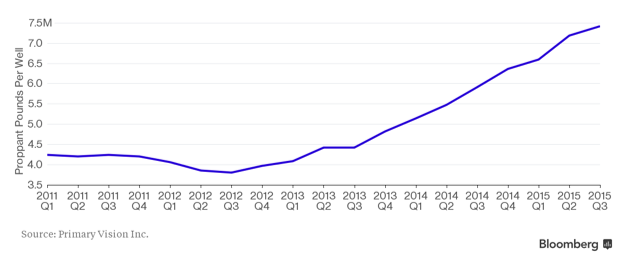Producers looking to get the most out of wells are increasing volumes of frac sand
In the current price environment, companies are doing everything they can to get the most out of their wells. Falling commodity prices have made wells increasingly uneconomical, a problem that is being acutely felt during quarterly reserves ceiling tests.
Operators are doing everything they can to increase the production from their wells, thus making them more economically attractive. One recurring theme is to use larger amounts of frac sand during the hydraulic fracturing process.
Brett Pennington, senior vice president of U.S. land operations for Murphy Oil Corp (ticker: MUR), has been experimenting with using up to 3,000 pounds per foot in some wells in the Eagle Ford, almost double the average of most wells in the play, according to Bloomberg.
“I can’t control the price of the commodity,” Pennington said in a recent interview. “The only thing we can do is get better and faster and cheaper. There’s a general correlation that more sand equates to a better well.”
This sentiment was echoed by Whiting Petroleum (ticker: WLL) Senior Vice President of Exploration and Development Mark Williams at the American Association of Petroleum Geologists (AAPG) convention in Denver in June. He said that one thing they found to be consistent was a “firm, strong correlation between higher volumes of sand and better production.”
The increase in sand usage has been steady. Back in 2012, the average well in the Eagle Ford received less than 1,000 pounds for every foot that the opening snaked down into the ground, according to energy consulting firm Wood Mackenzie Ltd. By 2013, that number was about 1,200 pounds. And last year it climbed to over 1,500 pounds. A study of more than 1,000 wells in the Eagle Ford — which accounts for 15% of all U.S. oil output — revealed that the injection of additional sand can triple output in some cases, according to Bloomberg Intelligence.
At some point, increased sand no longer translates into higher production, however. Murphy, along with Whiting and other companies with major fracing operations like EOG Resources (ticker: EOG), has been trying to find where that fine line in the proverbial sand is drawn. Adding too much sand into fracs runs the risk of obstructing the flow of oil.
“You get to the point where you’re jamming the fractures and your conductivity goes down,” said Jonathan Garrett, a Houston-based analyst for Wood Mackenzie.
A spokesperson for Synergy Resources (ticker: SYRG) talked with Oil & Gas 360® about the company’s sand volumes for completions. Synergy operates in the Wattenberg field in Weld County, Colorado. “We have used a range from a few hundred pounds per lateral foot, with an average around 1,000-1,100 pounds per foot.
Increasing efficiencies
With so much of the focus in today’s market being on controlling costs to optimize returns, major companies like Halliburton (ticker: HAL) have looked to streamline operations around their frac sand. During a September conference call, Jeff Miller, president of Halliburton, said non-productive time around sand was down 70% since the initiation of the company’s real-time rail-management system came online in November 2014. “The cost per ton is quite frankly, on a delivered basis, the lowest it has been in five years,” Miller said about the companies sand operations.
“We think about supply chain and the advances made there, the single largest category of spend being sand and proppants. Average volumes per well continue to rise in the major basins and sand per well has doubled just in the last two years and the leading edge actually continues to move higher on a per well basis,” said Miller.


